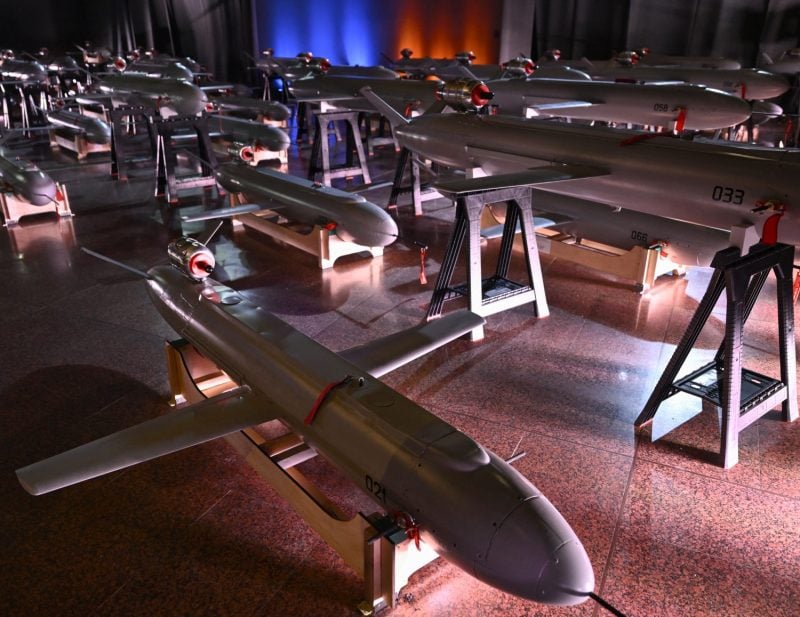What Trump’s Steel Tariffs Mean for China

What Trump’s Steel Tariffs Mean for China
Beijing stands to lose indirect access to the U.S. market, but it will be hard to dent its heavy industry.
An employee works at a factory producing stainless steel materials in Qingzhou, China, on Oct. 13, 2024. AFP via Getty Images
Welcome to Foreign Policy’s China Brief.
The highlights this week: U.S. tariffs on steel and aluminum aren’t likely to dent China’s dominance of the global market, China could become a more attractive destination for global science talent amid U.S. funding cuts, and Beijing seems to be mounting a full-court press to quash concerns about Chinese-made generic drugs.
Welcome to Foreign Policy’s China Brief.
The highlights this week: U.S. tariffs on steel and aluminum aren’t likely to dent China’s dominance of the global market, China could become a more attractive destination for global science talent amid U.S. funding cuts, and Beijing seems to be mounting a full-court press to quash concerns about Chinese-made generic drugs.
New Tariffs Indirectly Take Aim at China
On Monday, U.S. President Donald Trump announced 25 percent tariffs on steel and aluminum imports to the United States, part of a long-standing trade war aimed at China. The paradox is that China already barely exports steel or aluminum directly to the United States due to tariffs imposed under both Trump and former U.S. President Joe Biden.
However, China’s dominance of the global market—combined with overproduction and deflation at home—means that other countries are now awash in cheap Chinese metals. China produces 54 percent of the world’s steel and nearly 60 percent of global aluminum. Some of that still ends up in the United States after being repackaged by countries such as Vietnam.
Chinese production also allows Canada and Mexico to export their own metals while using steel from China to meet domestic needs. So the Trump administration’s logic is that if Beijing is evading tariffs via third countries anyway, the only way to really impose costs on China is to slap tariffs on everyone—unlike the Biden team’s more targeted approach.
It might be especially hard to make a dent in China’s steel juggernaut, though. Subsidies are still driving overproduction within China, thanks to policies put in place years ago. Until 2020, China’s booming property sector fueled demand for steel. However, the property bubble has started to deflate, and domestic steel demand has followed.
China’s steel production kept going up in the wake of the COVID-19 pandemic, spurred in part by economic stimulus efforts, even as prices have slid down. Cratering demand amid China’s economic crisis forced production down slightly last year. But prices are still at record lows, and firms mostly find demand overseas.
It may seem strange that the Chinese government keeps pumping the steel industry, especially given that before the pandemic, there was already a push to tackle overcapacity, including by using megamergers to consolidate production. The steel industry is also a major contributor to China’s carbon emissions, which has prompted efforts to upgrade to more advanced furnaces.
But most of China’s steel industry is state-run, which means that it both depends on and wields influence over the government. The industry only employs around 1.8 million people directly—but it tends to be very locally concentrated, with entire towns dependent on factories. That makes cutting steel jobs politically sensitive.
And steel industry decisions are also shaped by an element of Marxist nostalgia, given communism’s emphasis on heavy industry and the national might that it represented. And steel and aluminum still represent real power—both industrial and military. Even losing its indirect access to the U.S. market is unlikely to shake China’s grip on global metals.
What We’re Following
Will researchers choose China? With the Trump administration attempting to cut funding to U.S. scientific research, China might look like a relatively attractive destination for global talent. There is no shortage of major scientific projects in the country, from a planned next-generation supercollider to the $1 billion SinoProbe II geoscience survey starting this year.
Unlike in the United States, government support in China isn’t likely to disappear overnight: President Xi Jinping has made scientific advancement a long-term goal. Chinese scientists have increasingly preferred working at home rather than taking opportunities abroad, especially after a program called the China Initiative created during Trump’s first term targeted ethnically Chinese scientists.
There are substantial obstacles to bringing foreign talent to China. Beijing offers very few opportunities for long-term immigration, only yearlong visas, though reports have emerged indicating that may change for scientists. The Chinese institutional environment is also often hostile to foreigners, who might have difficulty with political tensions or even face pressure to engage in research misconduct.
But there are successful examples of integration—and the less attractive that the United States becomes, the more, perhaps, that China can shine by comparison.
Crackdown on military leaks. Chinese authorities have issued an even more draconian set of rules about sharing military-related content online. The Chinese People’s Liberation Army (PLA) is opaque even by Beijing standards and paranoid about spying. PLA soldiers live under intense rules—until 2018, they faced restrictions on mobile phone use even during personal time.
There remains at least one reliable source for Chinese military documents: the notoriously leak-prone forums of the game War Thunder, where many nationalists from all over the world with access to classified documents tend to share them. War Thunder uses real-life specs, so sharing secret information can help convince developers to make certain vehicles more powerful within the game.
Tech and Business
Generic drug crisis mode. After weeks of public anger about the reportedly poor quality of Chinese-made generic drugs, the central government is attempting a full-court press to kill the story. That involves both rebuttals from regulators and state media articles that claim that reports from doctors and patients about drugs not working are anecdotal.
The extent of the denials suggests that there is a serious crisis. China’s pharmaceutical industry is both very profitable and politically influential; opportunities for corruption in the sector, already quite normalized, blossomed during the COVID-19 pandemic. An anti-corruption campaign focused on health care in 2023 largely left big companies untouched.
Any problems within China’s pharmaceutical industry should concern U.S. authorities, since the United States regularly imports generic drugs from China.
DeepSeek propaganda. The R1 artificial intelligence model pioneered by Chinese lab DeepSeek has raised concerns among experts about Chinese media control by displaying a range of techniques long used by the government to shape or suppress stories. These include simple denial, presenting certain issues as stemming from foreign interference or outside criticism, and consistently treating the Chinese government as the most authoritative source.
It is not clear how much this behavior has been deliberately trained into the model versus how much is a natural development from being trained on Chinese data that features these same techniques—but it is noticeable that when it comes to legitimately dangerous information, the R1 model features less censorship than its Western counterparts.
FP’s Most Read This Week
- Trump’s Real Estate Envoy to the Middle East by Steven A. Cook
- The Chaos at USAID, Explained by John Haltiwanger and Christina Lu
- How Gaza Shattered the West’s Mythology by Pankaj Mishra
A Bit of Culture
In this passage from Dream-Memories of Tao’an, 17th-century memoirist Zhang Dai (1597-circa 1684) recalls a visit to the West Lake in Hangzhou, China, in the 12th month of the Chongzhen Emperor’s fifth year—so, January or early February in 1633.
“Mad” (chī) is an important word for Zhang, who uses it here and elsewhere in a positive sense—as in being “mad for something”—but as far as his boatman is concerned, going out on a cold, snowy night is mad in a more straightforward sense.—Brendan O’Kane, translator
“Snow at the Heart of the Lake”
From Dream-Memories of Tao’an by Zhang Dai
At the end of the Chongzhen Emperor’s fifth year (1633), when I was living by the West Lake, there were three days of heavy snowfall, and the usual sounds of humans and birds on the lake were replaced with silence.
One evening, just as night was falling, I took a small boat out to Heart-of-the-Lake Pavilion to watch the snow, wrapped tightly in furs and huddling over a charcoal burner. Sky, clouds, hills and lake were all the same white amid the fog and the frost, and the only reflections in the lake were a slash of causeway, a dot of pavilion, a mustard seed of a boat, and the two or three specks of ourselves aboard it.
We arrived at the pavilion and found two people sitting on a felt blanket, with a serving-boy warming wine in water that had just come to a boil. They were pleasantly surprised to see me— “Who’d have thought there’d be someone else out here!”—and dragged me over to drink with them.
I drank three large cups—they insisted—and excused myself, though not before asking their names. They turned out to be tourists, visiting from the southern capital. When I got back into the boat, the boatman muttered, “The gentleman may be mad, but I suppose he isn’t the only one.”
This post is part of FP’s ongoing coverage of the Trump administration. Follow along here.
James Palmer is a deputy editor at Foreign Policy. X: @BeijingPalmer
More from Foreign Policy
-

Russian President Vladimir Putin looks on during a press conference after meeting with French President in Moscow, on February 7, 2022. The Domino Theory Is Coming for Putin
A series of setbacks for Russia is only gaining momentum.
-

The container ship Gunde Maersk sits docked at the Port of Oakland on June 24, 2024 in Oakland, California. How Denmark Can Hit Back Against Trump on Greenland
The White House is threatening a close ally with a trade war or worse—but Copenhagen has leverage that could inflict instant pain on the U.S. economy.
-

Donald Trump speaks during an event commemorating the 400th Anniversary of the First Representative Legislative Assembly in Jamestown, Virginia on July 30, 2019. This Could Be ‘Peak Trump’
His return to power has been impressive—but the hard work is about to begin.
-

US Secretary of State Marco Rubio greets employees at the State Department in Washington, DC, on January 21, 2025. The National Security Establishment Needs Working-Class Americans
President Trump has an opportunity to unleash underutilized talent in tackling dangers at home and abroad.








Join the Conversation
Commenting on this and other recent articles is just one benefit of a Foreign Policy subscription.
Already a subscriber?
.
Subscribe
Subscribe
View Comments
Join the Conversation
Join the conversation on this and other recent Foreign Policy articles when you subscribe now.
Subscribe
Subscribe
Not your account?
View Comments
Join the Conversation
Please follow our comment guidelines, stay on topic, and be civil, courteous, and respectful of others’ beliefs.
Change your username |
Log out
Change your username:
CANCEL
Confirm your username to get started.
The default username below has been generated using the first name and last initial on your FP subscriber account. Usernames may be updated at any time and must not contain inappropriate or offensive language.